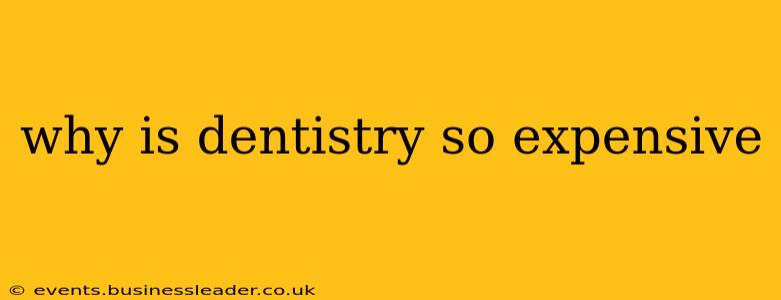Dental care costs can be surprisingly high, leaving many wondering why seemingly simple procedures carry hefty price tags. The expense isn't arbitrary; it's a complex issue stemming from a combination of factors. Understanding these factors is key to making informed decisions about your oral health and managing associated costs.
What are the main factors contributing to high dental costs?
Several key factors contribute to the high cost of dental care. These include:
-
High Education and Training Costs: Becoming a dentist requires extensive education and training, including years of undergraduate study, dental school, and often, specialized residencies. This lengthy and rigorous process translates into significant student loan debt for dentists, which ultimately impacts their fees. The specialized skills and knowledge required demand a commensurate compensation.
-
Advanced Technology and Equipment: Modern dentistry relies on sophisticated technology, from digital imaging and CAD/CAM restorations to lasers and sophisticated sterilization equipment. These technologies improve precision, efficiency, and patient comfort, but they come at a substantial cost to purchase, maintain, and update.
-
Operating Costs and Overhead: Dental practices have significant overhead expenses, including rent or mortgage payments for office space, utilities, insurance, staff salaries (including hygienists, assistants, and administrative personnel), and marketing. These fixed costs must be factored into the pricing of procedures.
-
Insurance Reimbursement Rates: While dental insurance can help mitigate costs, reimbursement rates from insurance companies often don't fully cover the actual cost of procedures. Dentists must account for this discrepancy in their pricing, leading to higher fees for patients.
-
The Cost of Materials: Dental materials, including fillings, crowns, implants, and other restorative materials, can be quite expensive. These costs are influenced by the quality of the materials used and advancements in dental technology. Biocompatible materials, while often more expensive, offer superior longevity and patient safety.
What are some ways to make dental care more affordable?
Many individuals struggle with the high cost of dental care, making affordability a crucial concern. Thankfully, there are several ways to access more affordable options:
-
Negotiating Payment Plans: Many dental practices offer payment plans or financing options to make larger procedures more manageable. Don't hesitate to discuss payment options with your dentist.
-
Dental Insurance: Although insurance doesn't always cover everything, it can significantly reduce out-of-pocket expenses. Explore different dental insurance plans and compare their coverage and premiums.
-
Dental Schools and Teaching Clinics: Dental schools often provide low-cost care performed by students under the supervision of experienced faculty. This is a great option for accessing quality care at a reduced price, although wait times might be longer.
-
Community Health Clinics: Many communities offer dental services at reduced or sliding-scale fees for low-income individuals and families. These clinics often provide essential care to those who might not otherwise be able to afford it.
-
Preventive Care: Regularly scheduled check-ups and cleanings are the most effective way to prevent expensive problems down the line. Investing in preventive care can save significant amounts of money in the long run.
What are the different types of dental insurance plans?
Dental insurance plans vary significantly in their coverage and costs. Generally, they fall into a few categories:
-
Dental HMO (Health Maintenance Organization): These plans usually involve a network of dentists you must choose from, typically requiring a referral to see a specialist. They often have lower monthly premiums but may have more restrictive coverage.
-
Dental PPO (Preferred Provider Organization): PPOs offer more flexibility, allowing you to see out-of-network dentists, although the cost will be higher. They usually have higher monthly premiums but often provide better coverage.
-
Discount Dental Plans: These aren't insurance plans in the traditional sense; instead, they offer discounts on dental services from participating dentists. They typically have lower monthly fees than traditional insurance plans.
Choosing the right plan depends on your individual needs and budget. Carefully compare plans before making a decision.
How can I find affordable dental care in my area?
Finding affordable dental care in your area can involve some research. Here are some avenues to explore:
-
Online Search Engines: Search online for "affordable dentists near me" or "low-cost dental clinics [your city/state]."
-
Local Health Departments: Contact your local health department or community health center; they often have resources and referrals for low-cost or free dental care.
-
State Dental Associations: Many state dental associations maintain websites with resources to help find affordable dental care.
Understanding the factors contributing to the high cost of dentistry empowers you to make informed decisions about your oral health and access affordable care. By proactively addressing your oral health needs and exploring available resources, you can maintain a healthy smile without breaking the bank.
